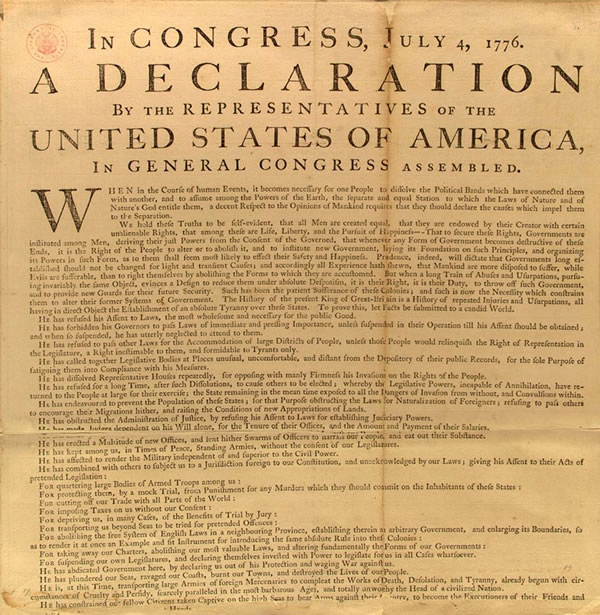Born on the Second of July… or August

“In Congress, July 4, 1776,” begins the Declaration of Independence, pictured above, “a declaration by the representatives of the United States of America, in general congress assembled.” From this document began the United States, and from that line comes Independence Day, celebrated annually in the U.S. on the fourth of July.
But some believe that July 4, 1776, is not truly America’s independence day. That honor should fall to either July 2, 1776, or August 2, 1776.
On June 11, 1776, the Continental Congress created a sub-committee of five delegates — Thomas Jefferson, John Adams, Benjamin Franklin, Roger R. Livingston, and Roger Sherman — empowered to write a first draft of a declaration of independence. Jefferson took the lead and the quintet delivered their draft on June 28th. After a few days of debates and revisions, the Congress voted to declare independence — on July 2nd, not July 4th.
The next day — July 3rd — Adams wrote a letter to his wife, Abigail, discussing the Declaration and its significance. In part, Adams wrote:
The Second Day of July 1776, will be the most memorable Epocha, in the History of America. I am apt to believe that it will be celebrated, by succeeding Generations, as the great anniversary Festival. It ought to be commemorated, as the Day of Deliverance by solemn Acts of Devotion to God Almighty. It ought to be solemnized with Pomp and Parade, with Shews, Games, Sports, Guns, Bells, Bonfires and Illuminations from one End of this Continent to the other from this Time forward forever more.
While Adams appropriately described the revelry, he whiffed on the date. Instead, we Americans celebrate independence on the 4th, the day the Continental Congress ratified the text of the document.
Ratified — but not signed. According to National Geographic, many of those who signed the famous piece of parchment simply were not present on the 4th of July and the document was not signed until August 2nd. This belief is buttressed by the journals of the Continental Congress itself; as stated by the National Archives, “on August 2, the journal of the Continental Congress records that ‘The declaration of independence being engrossed and compared at the table was signed.’ One of the most widely held misconceptions about the Declaration is that it was signed on July 4, 1776, by all the delegates in attendance.”
While the July 4th date is, probably, the least relevant of the three, it does lend itself to a fantastic coincidence. Of the five drafters of the Declaration, Adams and Jefferson would go on to become President of the United States. And both Adams and Jefferson share something else in common: both died on July 4, 1826 — fifty years to the day the Declaration was ratified.
Bonus fact: July 2nd is a special day for another reason. In non-leap years, it is the midpoint of the year — there are 182 days before it and 182 days after it. (This was not true in 1776 because that was a leap year.)
Take the Quiz: Name the signers of the Declaration of Independence.
From the Archives: The First American Flag Was Very British Looking: You’ll see.
Related: A collection of letters from John Adams to Abigail Adams, free on Kindle (and available in paperback, too, but not for free).

Leave a comment